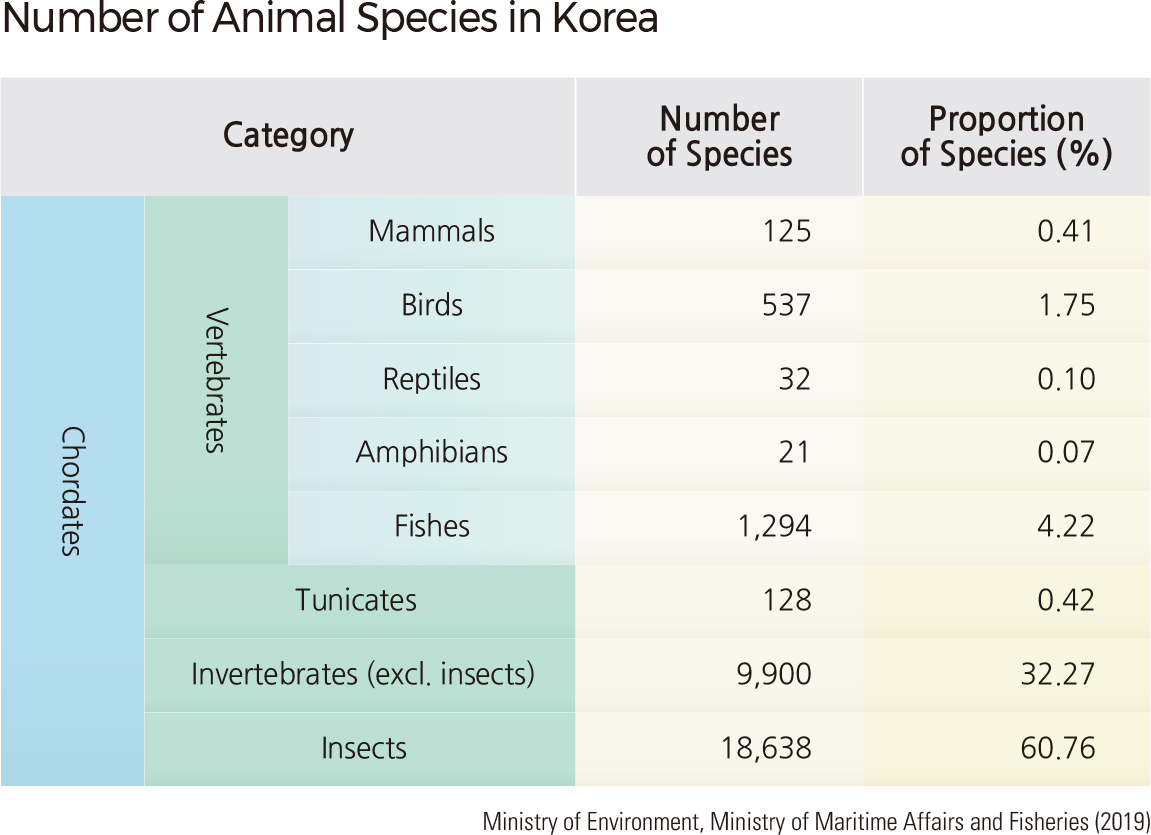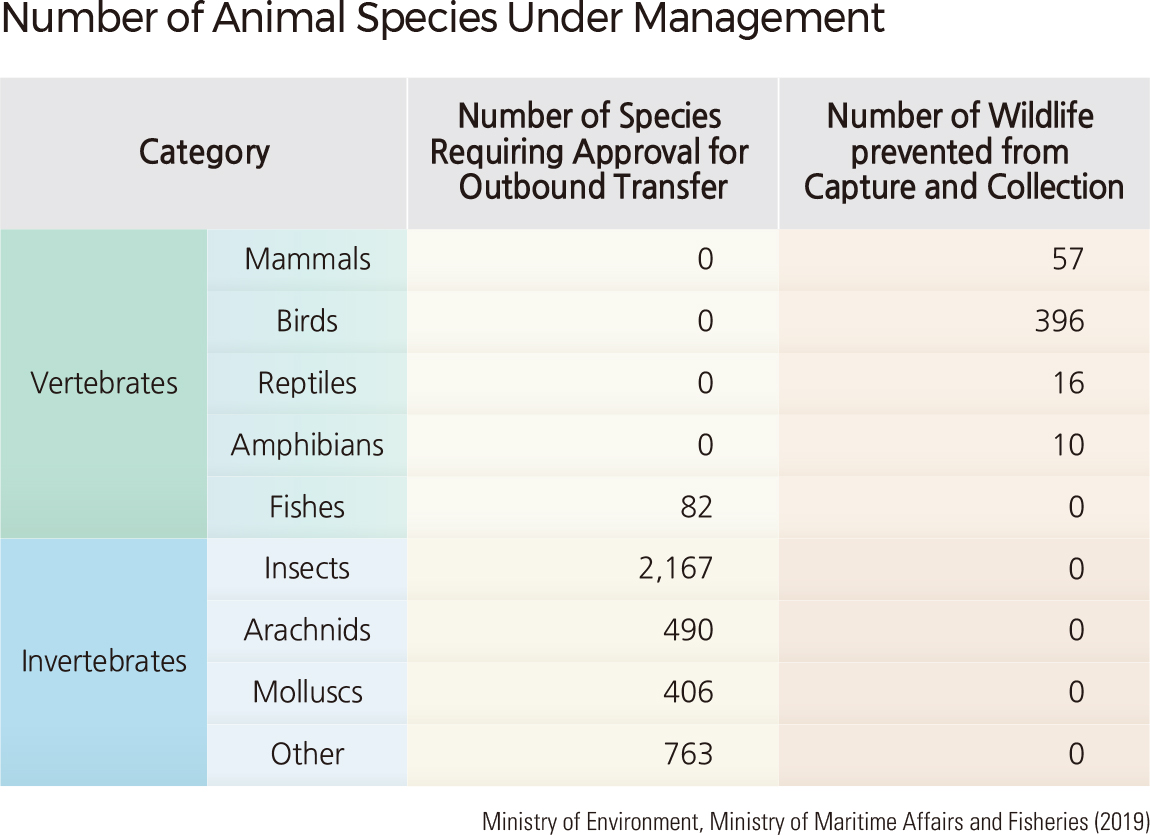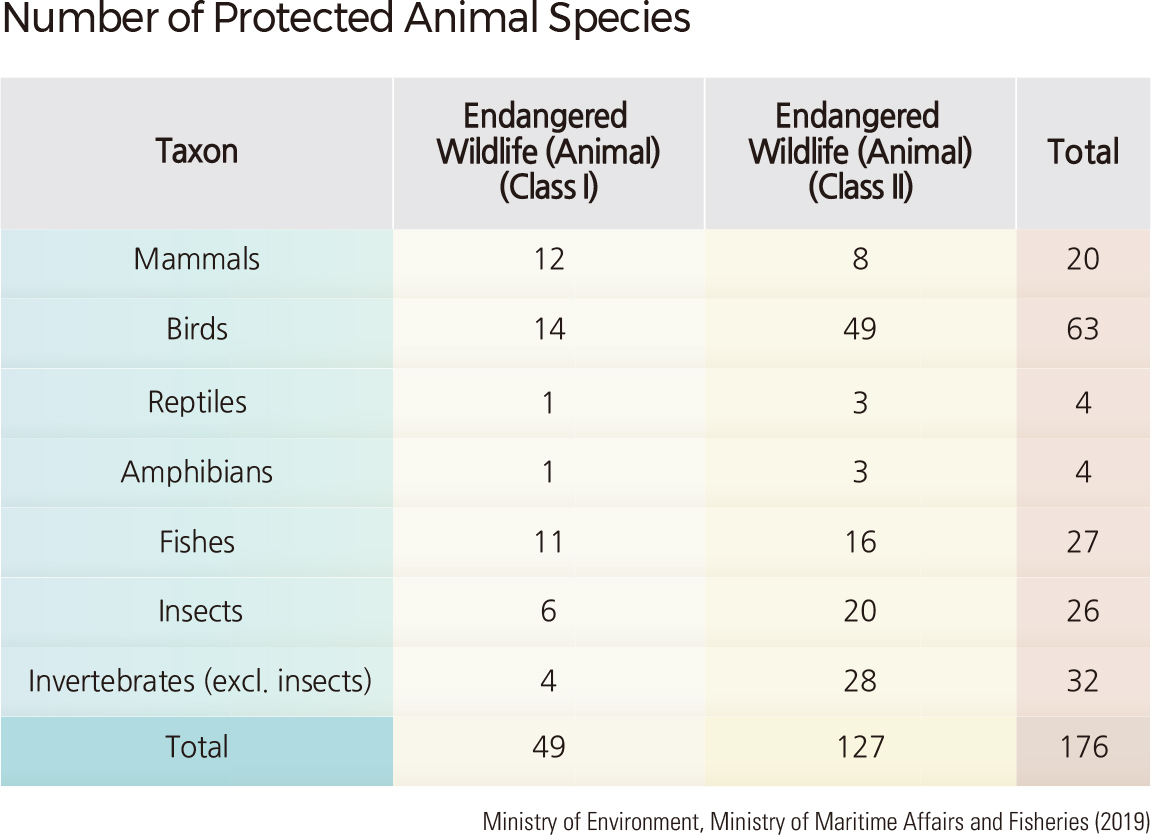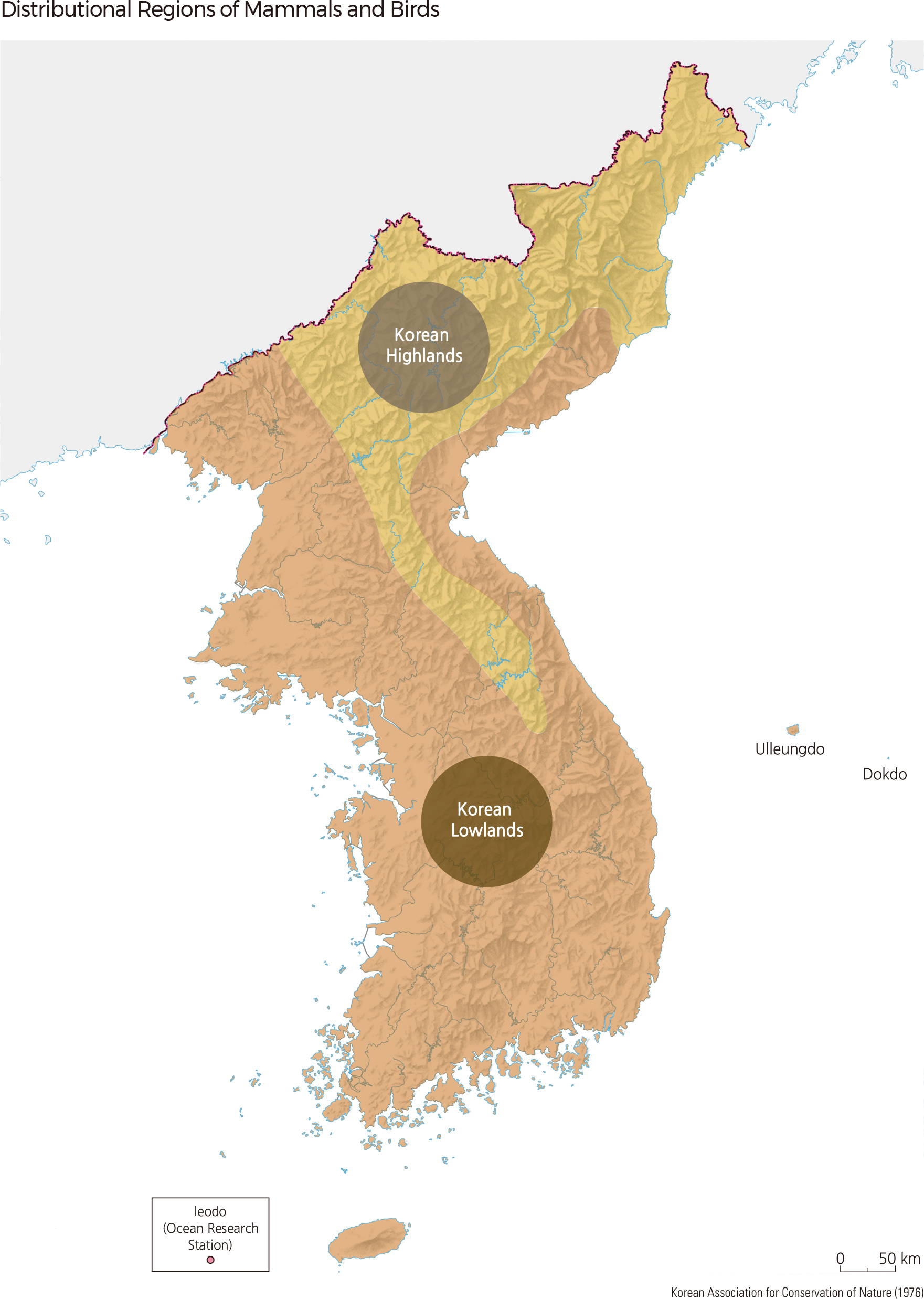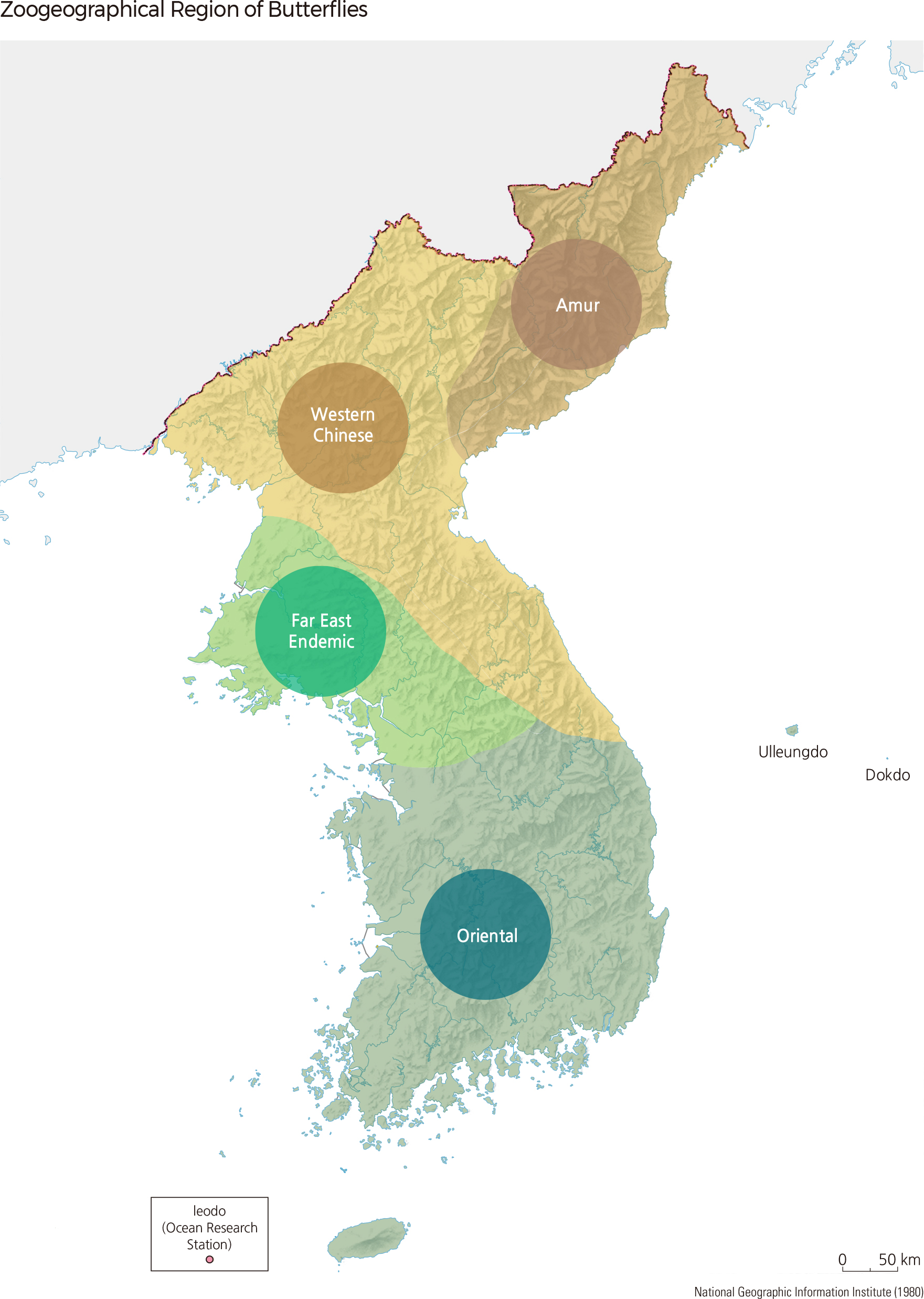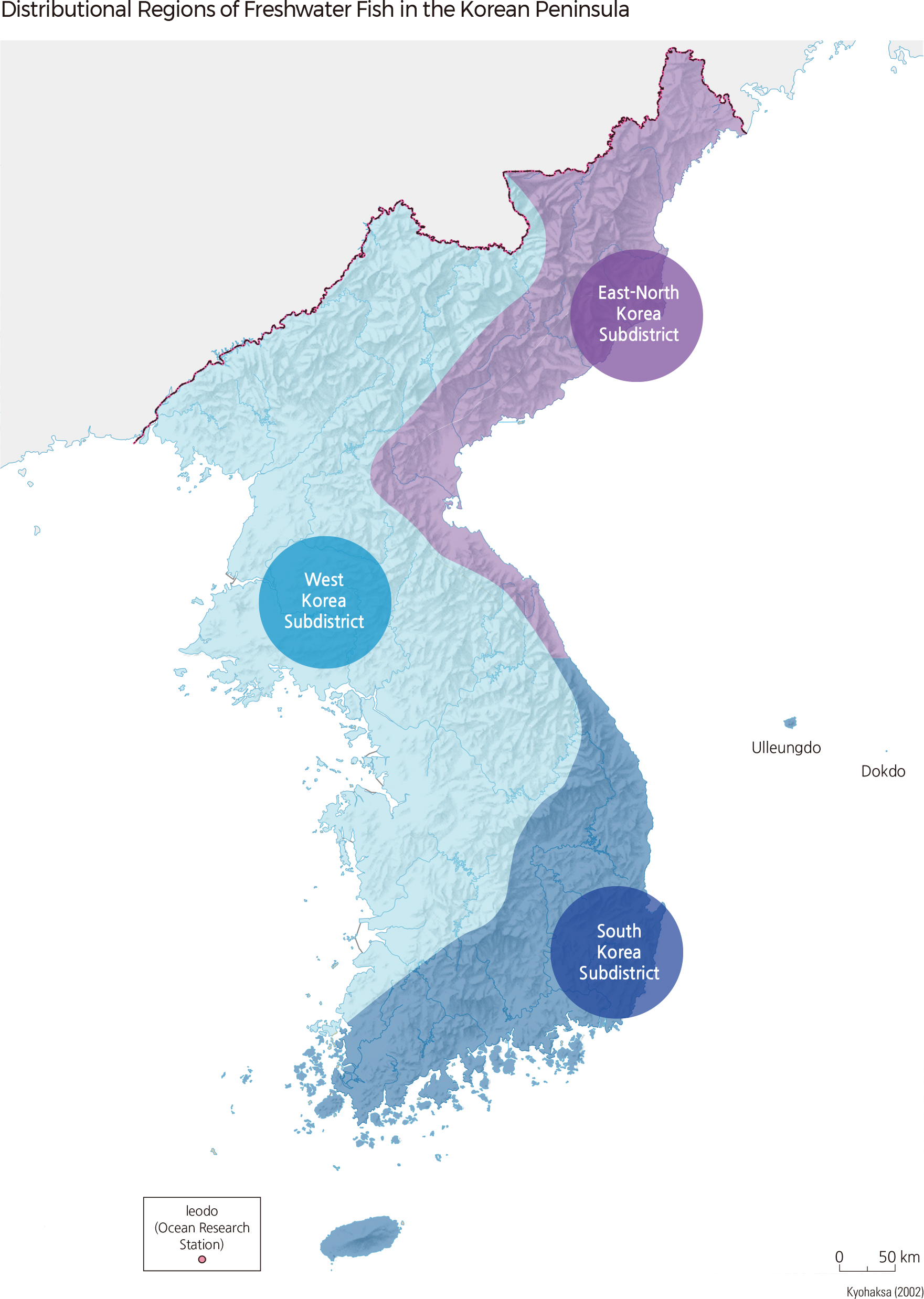English II 2020
The Korean Peninsula is ecologically isolated from the continent by the high mountain terrain of Baekdusan and two large rivers. The Amnokgang in the northwest and the Dumangang in the northeast act as barriers that limit wild animals' migration to Korea from China and Russia. The Baekdudaegan forms the core of mountain ranges in the Korean Peninsula. Its continuous ranges reach out to the seas on three sides of the Peninsula, forming the Hangang, Nakdonggang, Geumgang, Yeongsangang, and Seomjinjang. Residential areas in cities and villages and productive agricultural land and estuaries possess unique fauna. The Korean Demilitarized Zone (DMZ), subalpine zone, and islands play important roles as wintering, breeding, and stopover sites for migratory animals. In Korea, approximately 100,000 species of living organisms are estimated to inhabit the land, and 52,628 species have been identified and recorded. Among the recorded species, 30,675 species, which constitute 58.3% of the total, belong to the Kingdom Animalia, including 2,009 species of vertebrates, 128 species of tunicates, and 28,538 species of invertebrates.
Because of the Korean Peninsula's ecological isolation, freshwater fish and insects of the Peninsula include more endemic species than other taxa. Endemic species are those that are native to a particular geographic area and are not naturally found anywhere else in the world. Approximately 4.3% of all species found in Korea are endemic. Among higher-order animals, one mammalian species, one bird species, six amphibian species, and 66 fish species are endemic to Korea. Among marine organisms, there are approximately 32 species per 1,000 km2 of territorial water and Exclusive Economic Zone (EEZ), which is the highest diversity in the world, and 717 species are found in coastal wetlands. Endemic animal species inhabiting the Korean Peninsula account for 5.84% of indigenous animal species and include 74 vertebrate species, one tunicate species, and 1,716 invertebrate species.
Korea is also home to many species listed as endangered. Of the 267 Endangered Wildlife, 176 species are animals. Among marine organisms in Korean waters, 80 species are designated as marine organisms under protection, including endangered species living in the ocean or along the coast, species endemic to Korea, and species with high scientific and economic value. Of these 80 species, 73 are animals, including 16 marine mammals. Conservation projects for endangered wild animal species are conducted to target the Asiatic Black Bear (Ursus thibetanus ussuricus), Korean Goral (Naemorhedus caudatus), Korean Fox (Vulpes vulpes peculiosa), Oriental Stork (Ciconia boyciana), Crested Ibis (Nipponia nippon), Sea Horse (Hippocampus coronatus), Green Turtle (Chelonia mydas), and several other species. Twenty-eight Ex-situ conservation institution have been designated for conservation projects for endangered species and their habitat restoration: 13 institutes subsidized by the Ministry of Environment and 15 by the Ministry of Oceans and Fisheries. In addition, there are 10 medical care and rescue centers for protected marine animal species.
Recently, a decrease in the number of predators at higher trophic levels led to a population increase of small and mediumsized mammals such as Wild Boar (Sus scrofa) and Water Deer (Hydropotes inermis), which have damaged crops and cultivated areas. Some animals reverted to wild state have been affecting the faunal ecosystem. The government designates invasive animals and wild animals as ecosystem-disturbing species, harmful wild animals, and animals reverted to wild state to prevent disturbance of the ecosystem by invasive animals and damage to people and property by wild animals.
The major threats to wild animals are illegal hunting tools, poaching, trafficking, roadway mortality, and whaling.
The geographical distribution of animals is determined by habitat conditions in which landform, climate, hydrology, and vegetation are reflected. It is more difficult to distinguish animal zoogeographical regions because animals are more adaptable to the environment than plants and have mobility. According to Wallace's zoogeographic regions, the Korean Peninsula belongs to the Palearctic realm, which includes North Africa, Europe, and most of Asia. Only a few attempts have been made to categorize the zoogeographical region of the Korean Peninsula, and some attempts have been made on mammals, insects, and fish.
The Korean Peninsula is subdivided into the Korean Highlands and Korean Lowlands in relation to the distribution of mammal and bird species and vegetation zones. In the Korean Highlands, the natural environment and landscapes are similar to those of the Ussuri region in Russia and the northeastern region of China. Mammals such as Crocidura lasiura, Ochotona hyperborea, Vespertilio murinus, Martes zibellina, Mustela nivalis mosanensis, and Cervus nippon hortulorum inhabit the Korean Highlands. Highlands are also home to many bird species such as Lyrurus tetrix, Emberiza jankowskii, Picoides tridactylus, Surnia ulula, Dendrocopos minor, and Jynx torquilla.
The Korean Lowlands include the western, central, and southern parts of Korea, where temperate forests and warm-temperate forests develop. Since there are fewer mountainous areas but more cultivated lands, animals that are typically found in piedmont-plains inhabit the areas. Mammalian species such as Myotis formosus, Hydropotes inermis, Lasiopodomys mandarinus, and Sus scrofa are found in the Korean Lowlands, along with bird species such as Columba janthina, Microscelis amaurotis, and Zosterops japonicus.
Butterfly species are categorized into four zoogeographic regions, based on the distribution and composition (the ratio between the Palearctic Butterfly species and the Oriental Butterfly species). Oeneis urda, Clossiana angarensis, Euphydryas ichnea, and Albulina optilete are representative Palearctic species that have advanced south from the Amur region in Siberia. Species such as Seokia pratti, Nymphalis io, and Aporia hippia that originated in western China, Mongolia, and southern Manchuria and crossed the Amnokgang are typical of southern Chinese species. Mimathyma schrenckii, Nymphalis antiopa, and Aldania thisbe are the Far East endemic species. Species with an original zoogeographic distribution in Kyushu, Tsushima, and Ryukyu, such as Junonia almana, Parantica sita, Eurema hecabe, and Atrophaneura alcinous, are categorized as Oriental species.
Zoogeographical distribution of freshwater fish species is classified into the Northeast Korea Subdistrict, the South Korea Subdistrict, and the West Korea Subdistrict. Freshwater species such as Rhynchocypris semotilus and Cobitis pacifica are endemic to the Northeast Korea Subdistrict. Palearctic species such as Gobio cynocephalus, Phoxinus phoxinus, and Orthrias toni, which are believed to have originated from the Amur River, are also found in the Northeast Korea Subdistrict. Microphysogobio koreensis, Iksookimia longicorpa, and Niwaella multifasciata are found in the South Korea Subdistrict. Palearctic species such as Rhynchocypris oxycephalus and Lefua costata, and species with distribution in Japan such as Oryzias latipes and Coreoperca kawamebari are also found in the South Korea Subdistrict. Endemic species such as Hemibarbus mylodon, Pseudopungtungia nigra, Moroco kumgangensis, and Gobiobotia brevibarba, as well as Palearctic species such as Ladislavia taczanowskii and Phoxinus phoxinus, are found in the West Korea Subdistrict. |
